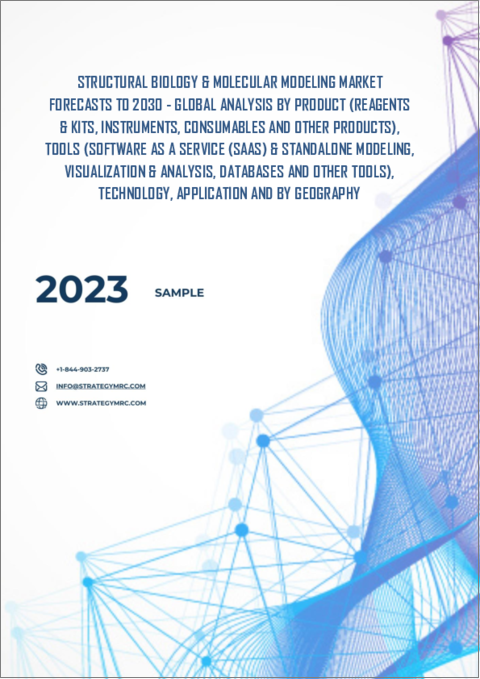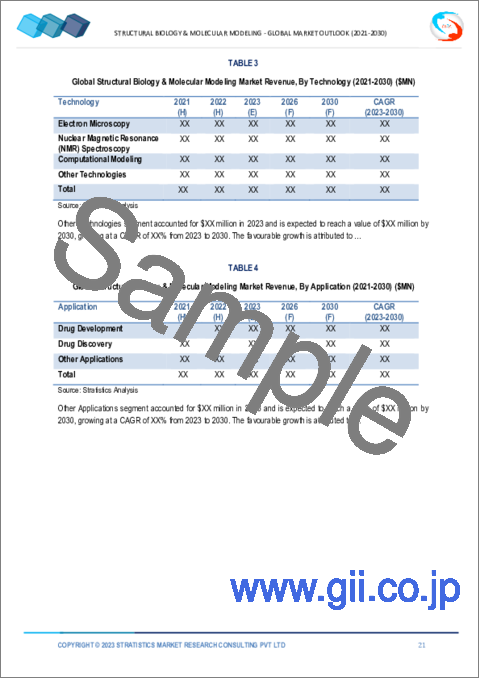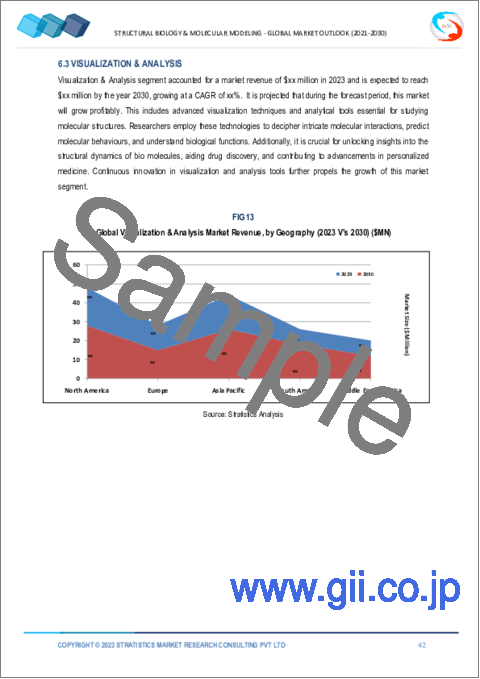|
|
市場調査レポート
商品コード
1403393
構造生物学および分子モデリング技術市場の2030年までの予測:製品別、ツール別、技術別、用途別、地域別の世界分析Structural Biology & Molecular Modeling Market Forecasts to 2030 - Global Analysis By Product, Tools (Software as a Service & Standalone Modeling, Visualization & Analysis, Databases and Other Tools), Technology, Application and By Geography |
||||||
カスタマイズ可能
|
|||||||
| 構造生物学および分子モデリング技術市場の2030年までの予測:製品別、ツール別、技術別、用途別、地域別の世界分析 |
|
出版日: 2024年01月01日
発行: Stratistics Market Research Consulting
ページ情報: 英文 200+ Pages
納期: 2~3営業日
|
全表示
- 概要
- 図表
- 目次
Stratistics MRCによると、世界の構造生物学・分子モデリング技術市場は2023年に49億1,000万米ドルを占め、予測期間中のCAGRは18.2%で成長し、2030年には158億5,000万米ドルに達すると予測されています。
構造生物学と分子モデリング技術は、密接に関連する2つの分野であり、生体高分子の構造と機能を分子レベルで理解する上で重要な役割を果たしています。構造生物学と分子モデリング技術は、基礎研究から医療、農業、産業における実用的な応用まで、幅広い用途に使用できる汎用性の高いツールです。生物学的プロセスを分子レベルで理解することで、様々な科学技術分野の進歩が促進されます。
2021年9月に発表されたMDPIジャーナルの調査論文によると、末梢動脈疾患(PAD)の有病率は3~12%と推定され、アメリカおよび欧州で約2,700万人が罹患しています。
成長促進要因:慢性疾患の増加
慢性疾患には複雑な分子経路が関与していることが多いです。構造生物学は、詳細な情報を提供することで、潜在的な創薬標的の同定と検証に役立ちます。構造生物学と分子モデリング技術は、潜在的な創薬標的の同定と特異的治療薬の設計に貢献します。がんや神経変性疾患などの慢性疾患の増加は、標的治療や個別化治療の需要を加速させています。
成長抑制要因:生物学的システムの限られた理解
進歩にもかかわらず、複雑な生物学的システムの理解はまだ発展途上です。標的タンパク質の三次元構造の理解が限られていると、効果的な薬剤候補の同定や設計の妨げになります。その結果、医薬品開発のスピードが遅くなり、効率が低下する可能性があります。さらに、タンパク質リガンド相互作用の予測精度の低さや生物学的システムの複雑さといった要因も市場の成長を妨げます。
機会:人工知能(AI)の統合
構造生物学と分子モデリング技術プロセスにおける人工知能(AI)と機械学習(ML)の統合は、データ解析のスピードと精度を高めます。AIアルゴリズムは、生物学的データを解析して潜在的な創薬標的を特定することができ、より効率的な創薬パイプラインを開発し、治療効果を向上させ、副作用を最小限に抑える機会を提供します。この統合により、この分野における創薬開発の効率性、正確性、全体的な成功率がさらに向上します。
脅威:高い初期費用
構造生物学や分子モデリング技術には、高価な装置やソフトウェア、熟練した人材が必要になることが多いです。最先端の技術や特殊な機器に大きく依存しています。また、最先端の研究所や専門施設を設立・維持するには、多額の設備投資が必要となります。さらに、ソフトウェアライセンスや解釈のための熟練した人材など、実験データの解析に関連する費用も初期費用全体の一因となり、市場の需要を妨げています。
COVID-19の影響
生命科学分野の多くの研究努力は、ワクチン開発、薬剤の再利用、ウイルスの構造と機能の解明など、COVIDに関連する研究に振り向けられました。このような資源の再配分は、構造生物学や分子モデリングなど、COVIDに関連しない研究分野にも影響を与えました。経済的な不確実性とパンデミック中の優先順位の変化により、研究プロジェクトの資金調達に課題が生じました。さらに、COVIDに対する治療法の発見が急務となったことで、抗ウイルス薬の発見への関心と投資が高まり、構造生物学や分子モデリング分野にも間接的な恩恵がもたらされました。
予測期間中、電子顕微鏡セグメントが最大になる見込み
電子顕微鏡セグメントは有利な成長を遂げると推定されます。電子顕微鏡技術は高解像度を提供し、研究者が分子レベル、さらには原子レベルで構造を可視化することを可能にします。電子顕微鏡は、構造生物学や分子モデリングにおける強力なツールであり、生物学的プロセスや疾病メカニズムの理解、創薬活動の促進に不可欠な詳細な構造情報を提供します。EM技術の絶え間ない進歩が、この分野における重要性をさらに高めています。
予測期間中、創薬セグメントのCAGRが最も高くなる見込み
創薬セグメントは、予測期間中に最も高いCAGR成長が見込まれます。構造生物学と分子モデリング技術は、疾患の分子メカニズムに関する貴重な洞察を提供し、新規治療薬の設計を促進することにより、創薬において重要な役割を果たしています。これらの技術は創薬パイプラインの合理化に役立ち、より効率的で費用対効果の高いものとなります。
最大のシェアを占める地域
アジア太平洋地域は、研究開発への投資と進歩の増加により、予測期間中に最大の市場シェアを占めると予測されます。アジア太平洋地域の製薬業界とバイオテクノロジー業界は、構造生物学および分子モデリングツールの需要に大きく貢献すると思われます。さらに、科学研究やバイオテクノロジーに対する政府の取り組みや資金援助は、市場にプラスの影響を与える可能性があります。
CAGRが最も高い地域
欧州は、継続的な進歩、共同研究、パートナーシップにより、予測期間中に最も高いCAGRを示すと予測されています。同地域における構造生物学と分子モデリング技術の研究促進には、政府資金、民間投資、助成金が重要な役割を果たしています。欧州市場の有力企業には、Dassault Systemes社、Agile Molecule社、Acellera Limited社などがあります。さらに、資金調達の可能性と個別化医療への関心の高まりは、欧州市場の成長に影響を与える可能性があります。
無料のカスタマイズサービス
本レポートをご購読のお客様には、以下の無料カスタマイズオプションのいずれかをご利用いただけます。
- 企業プロファイル
- 追加市場企業の包括的プロファイリング(3社まで)
- 主要企業のSWOT分析(3社まで)
- 地域セグメンテーション
- 顧客の関心に応じた主要国の市場推計・予測・CAGR(注:フィージビリティチェックによる)
- 競合ベンチマーキング
- 製品ポートフォリオ、地理的プレゼンス、戦略的提携に基づく主要企業のベンチマーキング
目次
第1章 エグゼクティブサマリー
第2章 序文
- 概要
- ステークホルダー
- 調査範囲
- 調査手法
- データマイニング
- データ分析
- データ検証
- 調査アプローチ
- 調査ソース
- 1次調査ソース
- 2次調査ソース
- 前提条件
第3章 市場動向分析
- 促進要因
- 抑制要因
- 機会
- 脅威
- 製品分析
- 技術分析
- 用途分析
- 新興市場
- 新型コロナウイルス感染症(COVID-19)の影響
第4章 ポーターのファイブフォース分析
- 供給企業の交渉力
- 買い手の交渉力
- 代替品の脅威
- 新規参入業者の脅威
- 競合関係
第5章 世界の構造生物学および分子モデリング技術市場:製品別
- 試薬とキット
- タンパク質精製試薬
- DNAおよびRNA抽出キット
- タンパク質結晶化試薬
- 機器
- X線結晶解析装置
- 核磁気共鳴(NMR)分光計
- 質量分析計
- 消耗品
- ピペットとチップ
- マイクロプレート
- 極低温保管
- その他の製品
第6章 世界の構造生物学および分子モデリング技術市場:ツール別
- Software as a Service(SaaS)とスタンドアロンモデリング
- 分子動力学
- 相同性モデリング
- ねじ切り
- アブイニシオ
- ハイブリッド
- 可視化と分析
- データベース
- その他のツール
第7章 世界の構造生物学および分子モデリング技術市場:技術別
- 電子顕微鏡法
- 核磁気共鳴(NMR)分光法
- 計算モデリング
- その他の技術
第8章 世界の構造生物学および分子モデリング技術市場:用途別
- 医薬品開発
- 創薬
- その他の用途
第9章 世界の構造生物学および分子モデリング技術市場:地域別
- 北米
- 米国
- カナダ
- メキシコ
- 欧州
- ドイツ
- 英国
- イタリア
- フランス
- スペイン
- その他欧州
- アジア太平洋地域
- 日本
- 中国
- インド
- オーストラリア
- ニュージーランド
- 韓国
- その他アジア太平洋地域
- 南米
- アルゼンチン
- ブラジル
- チリ
- その他南米
- 中東とアフリカ
- サウジアラビア
- アラブ首長国連邦
- カタール
- 南アフリカ
- その他中東とアフリカ
第10章 主な発展
- 契約、パートナーシップ、コラボレーション、合弁事業
- 買収と合併
- 新製品の発売
- 事業拡大
- その他の主要戦略
第11章 企業プロファイル
- Acellera Limited
- Thermo Fisher Scientific Inc
- Illumina Inc.
- Horiba
- Chemical Computing Group ULC
- Bruker Daltonics
- Agilent Technologies Inc.
- Charles River Laboratories
- Dassault Systemes
- Biomax Informatics AG
- Agile Molecule
- Bioinformatic LLC
List of Tables
- Table 1 Global Structural Biology & Molecular Modeling Market Outlook, By Region (2021-2030) ($MN)
- Table 2 Global Structural Biology & Molecular Modeling Market Outlook, By Product (2021-2030) ($MN)
- Table 3 Global Structural Biology & Molecular Modeling Market Outlook, By Reagents & Kits (2021-2030) ($MN)
- Table 4 Global Structural Biology & Molecular Modeling Market Outlook, By Protein Purification Reagents (2021-2030) ($MN)
- Table 5 Global Structural Biology & Molecular Modeling Market Outlook, By DNA & RNA Extraction Kits (2021-2030) ($MN)
- Table 6 Global Structural Biology & Molecular Modeling Market Outlook, By Protein Crystallization Reagents (2021-2030) ($MN)
- Table 7 Global Structural Biology & Molecular Modeling Market Outlook, By Instruments (2021-2030) ($MN)
- Table 8 Global Structural Biology & Molecular Modeling Market Outlook, By X-ray Crystallography Instruments (2021-2030) ($MN)
- Table 9 Global Structural Biology & Molecular Modeling Market Outlook, By Nuclear Magnetic Resonance (NMR) Spectrometers (2021-2030) ($MN)
- Table 10 Global Structural Biology & Molecular Modeling Market Outlook, By Mass Spectrometers (2021-2030) ($MN)
- Table 11 Global Structural Biology & Molecular Modeling Market Outlook, By Consumables (2021-2030) ($MN)
- Table 12 Global Structural Biology & Molecular Modeling Market Outlook, By Pipettes & Tips (2021-2030) ($MN)
- Table 13 Global Structural Biology & Molecular Modeling Market Outlook, By Microplates (2021-2030) ($MN)
- Table 14 Global Structural Biology & Molecular Modeling Market Outlook, By Cryogenic Storage (2021-2030) ($MN)
- Table 15 Global Structural Biology & Molecular Modeling Market Outlook, By Other Products (2021-2030) ($MN)
- Table 16 Global Structural Biology & Molecular Modeling Market Outlook, By Tools (2021-2030) ($MN)
- Table 17 Global Structural Biology & Molecular Modeling Market Outlook, By Software as a Service (SaaS) & Standalone Modeling (2021-2030) ($MN)
- Table 18 Global Structural Biology & Molecular Modeling Market Outlook, By Molecular Dynamics (2021-2030) ($MN)
- Table 19 Global Structural Biology & Molecular Modeling Market Outlook, By Homology Modeling (2021-2030) ($MN)
- Table 20 Global Structural Biology & Molecular Modeling Market Outlook, By Threading (2021-2030) ($MN)
- Table 21 Global Structural Biology & Molecular Modeling Market Outlook, By Ab Initio (2021-2030) ($MN)
- Table 22 Global Structural Biology & Molecular Modeling Market Outlook, By Hybrid (2021-2030) ($MN)
- Table 23 Global Structural Biology & Molecular Modeling Market Outlook, By Visualization & Analysis (2021-2030) ($MN)
- Table 24 Global Structural Biology & Molecular Modeling Market Outlook, By Databases (2021-2030) ($MN)
- Table 25 Global Structural Biology & Molecular Modeling Market Outlook, By Other Tools (2021-2030) ($MN)
- Table 26 Global Structural Biology & Molecular Modeling Market Outlook, By Technology (2021-2030) ($MN)
- Table 27 Global Structural Biology & Molecular Modeling Market Outlook, By Electron Microscopy (2021-2030) ($MN)
- Table 28 Global Structural Biology & Molecular Modeling Market Outlook, By Nuclear Magnetic Resonance (NMR) Spectroscopy (2021-2030) ($MN)
- Table 29 Global Structural Biology & Molecular Modeling Market Outlook, By Computational Modeling (2021-2030) ($MN)
- Table 30 Global Structural Biology & Molecular Modeling Market Outlook, By Other Technologies (2021-2030) ($MN)
- Table 31 Global Structural Biology & Molecular Modeling Market Outlook, By Application (2021-2030) ($MN)
- Table 32 Global Structural Biology & Molecular Modeling Market Outlook, By Drug Development (2021-2030) ($MN)
- Table 33 Global Structural Biology & Molecular Modeling Market Outlook, By Drug Discovery (2021-2030) ($MN)
- Table 34 Global Structural Biology & Molecular Modeling Market Outlook, By Other Applications (2021-2030) ($MN)
Note: Tables for North America, Europe, APAC, South America, and Middle East & Africa Regions are also represented in the same manner as above.
According to Stratistics MRC, the Global Structural Biology & Molecular Modeling Market is accounted for $4.91 billion in 2023 and is expected to reach $15.85 billion by 2030 growing at a CAGR of 18.2% during the forecast period. Structural Biology and Molecular Modeling are two closely related fields that play a crucial role in understanding the structure and function of biological macromolecules at the molecular level. They are versatile tools with applications ranging from basic research to practical applications in medicine, agriculture, and industry. They provide a molecular-level understanding of biological processes, facilitating advancements in various scientific and technological fields.
According to the MDPI Journal research article published in September 2021, the prevalence of Peripheral Arterial Disease (PAD) is estimated to be 3-12%, affecting nearly 27 million people in America and Europe.
Market Dynamics:
Driver:
Rising incidence of chronic diseases
Chronic diseases often involve complex molecular pathways. Structural biology helps identify and validate potential drug targets by providing detailed information. Structural biology and molecular modeling contribute to the identification of potential drug targets and the design of specific therapeutics. The increasing prevalence of chronic diseases, such as cancer and neurodegenerative disorders, has fuelled the demand for targeted and personalized therapies.
Restraint:
Limited understanding of biological systems
Despite advancements, understanding of complex biological systems is still evolving. A limited understanding of the three-dimensional structures of target proteins can impede the identification and design of effective drug candidates. This can result in a slower and less efficient drug development process. Additionally, factors such as inaccuracy in predicting protein-ligand interactions and complexities of biological systems hampers the market growth.
Opportunity:
Integration of artificial intelligence (AI)
The integration of artificial intelligence (AI) and machine learning (ML) in structural biology and molecular modeling processes enhances the speed and accuracy of data analysis. AI algorithms can analyze biological data to identify potential drug targets. It presents opportunities for the development of more efficient drug discovery pipelines, improving treatment efficacy and minimizing side effects. This integration further enhances the efficiency, accuracy, and overall success rate of drug discovery and development efforts in this field.
Threat:
High initial costs
Structural biology and molecular modeling techniques often involve expensive equipment, software, and skilled personnel. They heavily rely on cutting-edge technologies and specialized equipment. Also, establishing & maintaining state-of-the-art laboratories and specialized facilities requires significant capital investment. Additionally, the costs associated with analyzing experimental data, including software licenses and skilled personnel for interpretation contribute to the overall initial expenses thereby hampering the market demand.
COVID-19 Impact
Many research efforts in the life sciences were redirected toward covid related studies, including vaccine development, drug repurposing, and understanding the virus's structure and function. This redirection of resources has impacted non-covid-related research areas, including structural biology and molecular modeling. Economic uncertainties and shifting priorities during the pandemic have led to funding challenges for research projects. Further, the urgency of finding treatments for covid has spurred increased interest and investment in antiviral drug discovery, which indirectly benefitted the structural biology and molecular modeling sector.
The electron microscopy segment is expected to be the largest during the forecast period
The electron microscopy segment is estimated to have a lucrative growth. Electron microscopy technique offers high resolution and allows researchers to visualize structures at the molecular and even atomic levels. It is a powerful tool in structural biology and molecular modeling, providing detailed structural information that is crucial for understanding biological processes, disease mechanisms, and facilitating drug discovery efforts. The continuous advancements in EM technology further contribute to its significance in the field.
The drug discovery segment is expected to have the highest CAGR during the forecast period
The drug discovery segment is anticipated to witness the highest CAGR growth during the forecast period. Structural biology and molecular modeling play crucial roles in drug discovery by providing valuable insights into the molecular mechanisms of diseases and facilitating the design of novel therapeutic agents. These techniques help streamline the drug discovery pipeline, making it more efficient and cost-effective.
Region with largest share:
Asia Pacific is projected to hold the largest market share during the forecast period owing to the increasing investments and advances in research and development. The pharmaceutical and biotechnology industries in the Asia Pacific region are likely to contribute significantly to the demand for structural biology and molecular modeling tools. Further, government initiatives and funding for scientific research and biotechnology can positively influence the market.
Region with highest CAGR:
Europe is projected to have the highest CAGR over the forecast period, owing to the continuous advancements, collaborations and partnerships. Government funding, private investments and grants play a significant role in advancing research in structural biology and molecular modeling in the region. Some prominent players in the European market include Dassault Systemes, Agile Molecule and Acellera Limited. Further, funding availability and growing emphasis on personalized medicine can impact the growth of the market in europe.
Key players in the market:
Some of the key players profiled in the Structural Biology & Molecular Modeling Market include Acellera Limited, Thermo Fisher Scientific Inc, Illumina Inc., Horiba, Chemical Computing Group ULC, Bruker Daltonics, Agilent Technologies Inc., Charles River Laboratories, Dassault Systemes, Biomax Informatics AG, Agile Molecule and Bioinformatic LLC.
Key Developments:
In November 2023, The Accelra Company released a new version of ACEMD, Accela's molecular dynamics simulation software. ACEMD is a highly optimized molecular dynamics (MD) engine that runs on NVIDIA GPUs. It's free for non-profit research, but commercial licenses are available for other uses.
In September 2023, Thermo Scientific launched the new Hydra Bio Plasma-Focused Ion Beam (Plasma-FIB) for cell biologists seeking simplified workflows while undertaking volume electron microscopy for cryo or resin-embedded samples. The Hydra Bio Plasma-FIB is a versatile, multi-application instrument that supports volume electron microscopy and sample preparation for the cryo-electron tomography workflow.
Products Covered:
- Reagents & Kits
- Instruments
- Consumables
- Other Products
Tools Covered:
- Software as a Service (SaaS) & Standalone Modeling
- Visualization & Analysis
- Databases
- Other Tools
Technologies Covered:
- Electron Microscopy
- Nuclear Magnetic Resonance (NMR) Spectroscopy
- Computational Modeling
- Other Technologies
Applications Covered:
- Drug Development
- Drug Discovery
- Other Applications
Regions Covered:
- North America
- US
- Canada
- Mexico
- Europe
- Germany
- UK
- Italy
- France
- Spain
- Rest of Europe
- Asia Pacific
- Japan
- China
- India
- Australia
- New Zealand
- South Korea
- Rest of Asia Pacific
- South America
- Argentina
- Brazil
- Chile
- Rest of South America
- Middle East & Africa
- Saudi Arabia
- UAE
- Qatar
- South Africa
- Rest of Middle East & Africa
What our report offers:
- Market share assessments for the regional and country-level segments
- Strategic recommendations for the new entrants
- Covers Market data for the years 2021, 2022, 2023, 2026, and 2030
- Market Trends (Drivers, Constraints, Opportunities, Threats, Challenges, Investment Opportunities, and recommendations)
- Strategic recommendations in key business segments based on the market estimations
- Competitive landscaping mapping the key common trends
- Company profiling with detailed strategies, financials, and recent developments
- Supply chain trends mapping the latest technological advancements
Free Customization Offerings:
All the customers of this report will be entitled to receive one of the following free customization options:
- Company Profiling
- Comprehensive profiling of additional market players (up to 3)
- SWOT Analysis of key players (up to 3)
- Regional Segmentation
- Market estimations, Forecasts and CAGR of any prominent country as per the client's interest (Note: Depends on feasibility check)
- Competitive Benchmarking
- Benchmarking of key players based on product portfolio, geographical presence, and strategic alliances
Table of Contents
1 Executive Summary
2 Preface
- 2.1 Abstract
- 2.2 Stake Holders
- 2.3 Research Scope
- 2.4 Research Methodology
- 2.4.1 Data Mining
- 2.4.2 Data Analysis
- 2.4.3 Data Validation
- 2.4.4 Research Approach
- 2.5 Research Sources
- 2.5.1 Primary Research Sources
- 2.5.2 Secondary Research Sources
- 2.5.3 Assumptions
3 Market Trend Analysis
- 3.1 Introduction
- 3.2 Drivers
- 3.3 Restraints
- 3.4 Opportunities
- 3.5 Threats
- 3.6 Product Analysis
- 3.7 Technology Analysis
- 3.8 Application Analysis
- 3.9 Emerging Markets
- 3.10 Impact of Covid-19
4 Porters Five Force Analysis
- 4.1 Bargaining power of suppliers
- 4.2 Bargaining power of buyers
- 4.3 Threat of substitutes
- 4.4 Threat of new entrants
- 4.5 Competitive rivalry
5 Global Structural Biology & Molecular Modeling Market, By Product
- 5.1 Introduction
- 5.2 Reagents & Kits
- 5.2.1 Protein Purification Reagents
- 5.2.2 DNA & RNA Extraction Kits
- 5.2.3 Protein Crystallization Reagents
- 5.3 Instruments
- 5.3.1 X-ray Crystallography Instruments
- 5.3.2 Nuclear Magnetic Resonance (NMR) Spectrometers
- 5.3.3 Mass Spectrometers
- 5.4 Consumables
- 5.4.1 Pipettes & Tips
- 5.4.2 Microplates
- 5.4.3 Cryogenic Storage
- 5.5 Other Products
6 Global Structural Biology & Molecular Modeling Market, By Tools
- 6.1 Introduction
- 6.2 Software as a Service (SaaS) & Standalone Modeling
- 6.2.1 Molecular Dynamics
- 6.2.2 Homology Modeling
- 6.2.3 Threading
- 6.2.4 Ab Initio
- 6.2.5 Hybrid
- 6.3 Visualization & Analysis
- 6.4 Databases
- 6.5 Other Tools
7 Global Structural Biology & Molecular Modeling Market, By Technology
- 7.1 Introduction
- 7.2 Electron Microscopy
- 7.3 Nuclear Magnetic Resonance (NMR) Spectroscopy
- 7.4 Computational Modeling
- 7.5 Other Technologies
8 Global Structural Biology & Molecular Modeling Market, By Application
- 8.1 Introduction
- 8.2 Drug Development
- 8.3 Drug Discovery
- 8.4 Other Applications
9 Global Structural Biology & Molecular Modeling Market, By Geography
- 9.1 Introduction
- 9.2 North America
- 9.2.1 US
- 9.2.2 Canada
- 9.2.3 Mexico
- 9.3 Europe
- 9.3.1 Germany
- 9.3.2 UK
- 9.3.3 Italy
- 9.3.4 France
- 9.3.5 Spain
- 9.3.6 Rest of Europe
- 9.4 Asia Pacific
- 9.4.1 Japan
- 9.4.2 China
- 9.4.3 India
- 9.4.4 Australia
- 9.4.5 New Zealand
- 9.4.6 South Korea
- 9.4.7 Rest of Asia Pacific
- 9.5 South America
- 9.5.1 Argentina
- 9.5.2 Brazil
- 9.5.3 Chile
- 9.5.4 Rest of South America
- 9.6 Middle East & Africa
- 9.6.1 Saudi Arabia
- 9.6.2 UAE
- 9.6.3 Qatar
- 9.6.4 South Africa
- 9.6.5 Rest of Middle East & Africa
10 Key Developments
- 10.1 Agreements, Partnerships, Collaborations and Joint Ventures
- 10.2 Acquisitions & Mergers
- 10.3 New Product Launch
- 10.4 Expansions
- 10.5 Other Key Strategies
11 Company Profiling
- 11.1 Acellera Limited
- 11.2 Thermo Fisher Scientific Inc
- 11.3 Illumina Inc.
- 11.4 Horiba
- 11.5 Chemical Computing Group ULC
- 11.6 Bruker Daltonics
- 11.7 Agilent Technologies Inc.
- 11.8 Charles River Laboratories
- 11.9 Dassault Systemes
- 11.10 Biomax Informatics AG
- 11.11 Agile Molecule
- 11.12 Bioinformatic LLC






